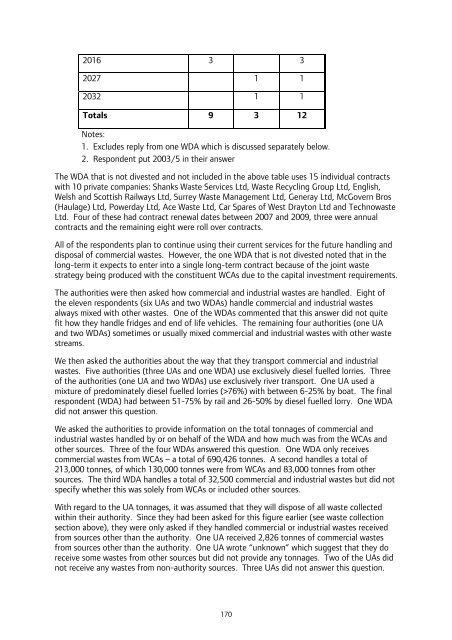London Wider Waste Strategy - London - Greater London Authority
London Wider Waste Strategy - London - Greater London Authority
London Wider Waste Strategy - London - Greater London Authority
Create successful ePaper yourself
Turn your PDF publications into a flip-book with our unique Google optimized e-Paper software.
2016 3 3<br />
2027 1 1<br />
2032 1 1<br />
Totals 9 3 12<br />
Notes:<br />
1. Excludes reply from one WDA which is discussed separately below.<br />
2. Respondent put 2003/5 in their answer<br />
The WDA that is not divested and not included in the above table uses 15 individual contracts<br />
with 10 private companies: Shanks <strong>Waste</strong> Services Ltd, <strong>Waste</strong> Recycling Group Ltd, English,<br />
Welsh and Scottish Railways Ltd, Surrey <strong>Waste</strong> Management Ltd, Generay Ltd, McGovern Bros<br />
(Haulage) Ltd, Powerday Ltd, Ace <strong>Waste</strong> Ltd, Car Spares of West Drayton Ltd and Technowaste<br />
Ltd. Four of these had contract renewal dates between 2007 and 2009, three were annual<br />
contracts and the remaining eight were roll over contracts.<br />
All of the respondents plan to continue using their current services for the future handling and<br />
disposal of commercial wastes. However, the one WDA that is not divested noted that in the<br />
long-term it expects to enter into a single long-term contract because of the joint waste<br />
strategy being produced with the constituent WCAs due to the capital investment requirements.<br />
The authorities were then asked how commercial and industrial wastes are handled. Eight of<br />
the eleven respondents (six UAs and two WDAs) handle commercial and industrial wastes<br />
always mixed with other wastes. One of the WDAs commented that this answer did not quite<br />
fit how they handle fridges and end of life vehicles. The remaining four authorities (one UA<br />
and two WDAs) sometimes or usually mixed commercial and industrial wastes with other waste<br />
streams.<br />
We then asked the authorities about the way that they transport commercial and industrial<br />
wastes. Five authorities (three UAs and one WDA) use exclusively diesel fuelled lorries. Three<br />
of the authorities (one UA and two WDAs) use exclusively river transport. One UA used a<br />
mixture of predominately diesel fuelled lorries (>76%) with between 6-25% by boat. The final<br />
respondent (WDA) had between 51-75% by rail and 26-50% by diesel fuelled lorry. One WDA<br />
did not answer this question.<br />
We asked the authorities to provide information on the total tonnages of commercial and<br />
industrial wastes handled by or on behalf of the WDA and how much was from the WCAs and<br />
other sources. Three of the four WDAs answered this question. One WDA only receives<br />
commercial wastes from WCAs – a total of 690,426 tonnes. A second handles a total of<br />
213,000 tonnes, of which 130,000 tonnes were from WCAs and 83,000 tonnes from other<br />
sources. The third WDA handles a total of 32,500 commercial and industrial wastes but did not<br />
specify whether this was solely from WCAs or included other sources.<br />
With regard to the UA tonnages, it was assumed that they will dispose of all waste collected<br />
within their authority. Since they had been asked for this figure earlier (see waste collection<br />
section above), they were only asked if they handled commercial or industrial wastes received<br />
from sources other than the authority. One UA received 2,826 tonnes of commercial wastes<br />
from sources other than the authority. One UA wrote “unknown” which suggest that they do<br />
receive some wastes from other sources but did not provide any tonnages. Two of the UAs did<br />
not receive any wastes from non-authority sources. Three UAs did not answer this question.<br />
170
















